Rollup Economics 2.0: Analyzing the Multi-layer Economic Relationships of a Mature Rollup Ecosystem
Written by: davidecrapis.eth
Compiled by: Deep Tide TechFlow
In February 2022, Barnabé proposed a Rollup economic framework for resource pricing and value flow, aimed at thinking about key concepts such as MEV, the interaction of L1 and L2 fees, operator revenue and costs in an L1-dependent economy. This is a simple framework suitable for a straightforward world: centralized Rollups running on independent auxiliary chains. A lot has changed in the past 18 months: shared ordering, decentralization, proof/data aggregation, Rollup alliances, governance.
We propose a new framework that will help understand the new world where Rollups are ready to scale. A lot of experimentation is still ongoing, but several patterns have already emerged. We will analyze key patterns and hope to provide a tool to help understand the possible directions of development and address current open questions.
Going Back to Basics: Revisiting Rollup Economics 1.0
The original Rollup economic framework included three entities: users, Rollup operators, and the base layer. It also had a similar simplified view involving value flow: L2 fees and MEV, operator costs, and data publication costs. This is a simple framework, but it is useful to start from here and build upon it, as things will quickly become more interesting and complex.
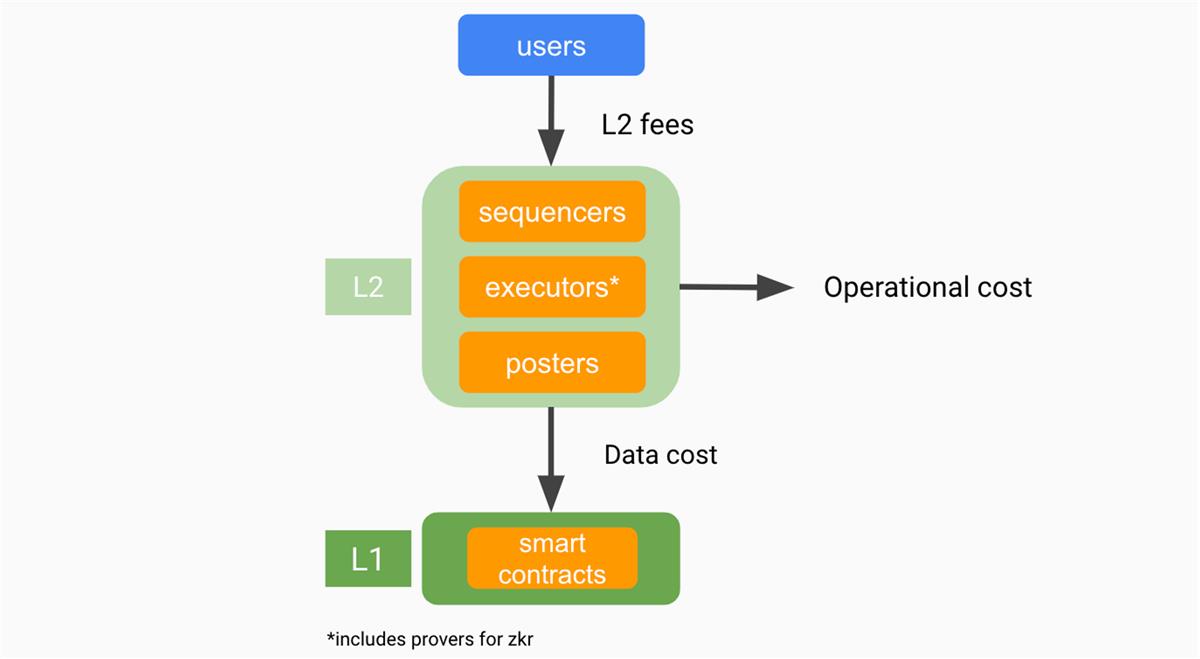
From these basic flows, we can measure the Rollup protocol surplus and reason about related concepts, such as the extraction and distribution of MEV, L2 issuance, L2 congestion fee distribution, and the timeframe for Rollups to maintain budget balance or achieve budget surplus (the L2 ecosystem is a growing economy that may find operational surplus useful for funding public goods, development, and growth).
Rollup Protocol Surplus = L2 fees - Operating costs - Data costs
The Rollup protocol has control over its L2 fees (including congestion pricing and MEV) and operating costs (including issuance and operator rewards). Whether the protocol decides to pursue balance or surplus goals, L2 operations need to coordinate technology to:
(1) optimally set L2 congestion fees,
(2) extract and redistribute MEV,
(3) reduce data costs through optimization and strategic publication.
These are the main economic design choices that different L2 ecosystems are currently experimenting with. In the future, protocols may wish to reduce the uncertainty of data costs by using block space derivatives.
One significant change has occurred in the past 18 months. Similar to L1 block building, we see Rollup operators being decomposed into more specialized roles. As the economy grows, specialization naturally emerges, which is a good thing, as the separation of concerns leads to more resilient systems if we can address this in the design. However, the design space is now larger, so we need a new map to guide our process.
Rollups are Maturing
As Rollups mature, their complexity is increasing, which we refer to as "Rollup alliances." The Rollup architecture shared among similar types of Rollups is designed to enhance security (through shared governance and community coordination), efficiency (through shared functionalities and economies of scale), and user experience (through better interoperability and reduced fragmentation). Meanwhile, independent providers are developing infrastructure to offer one or more of the above benefits to any Rollup that chooses their services. We will elaborate on these models below.

Independent Rollups
Individual Rollups are breaking away from auxiliary chains, increasing security and decentralization. From an operational/economic perspective, the main cost areas include:
Ordering: This incurs operational costs and incentive costs to motivate orderers.
Data Availability (DA): Rollups must publish data on the base layer, leading to data costs, which were the main cost item discussed in the original framework.
State Validation (SV): This directly increases the operational costs of zkRollups through proof costs.
In all these cost areas, a single Rollup faces significant trade-offs between security and efficiency. For example, they may choose to use a less secure data availability layer with lower costs. Data publication costs (which we refer to as data costs, although they include some L1 computation costs related to publication) have historically been the highest item. The quick implementation of EIP-4844 on Ethereum and the subsequent full implementation of Danksharding will significantly reduce this, providing Rollups with the necessary cost-effectiveness to scale and support new use cases. In the long run, the efficiency of data costs and related services may be achieved through off-chain innovative aggregation to unlock economies of scale.
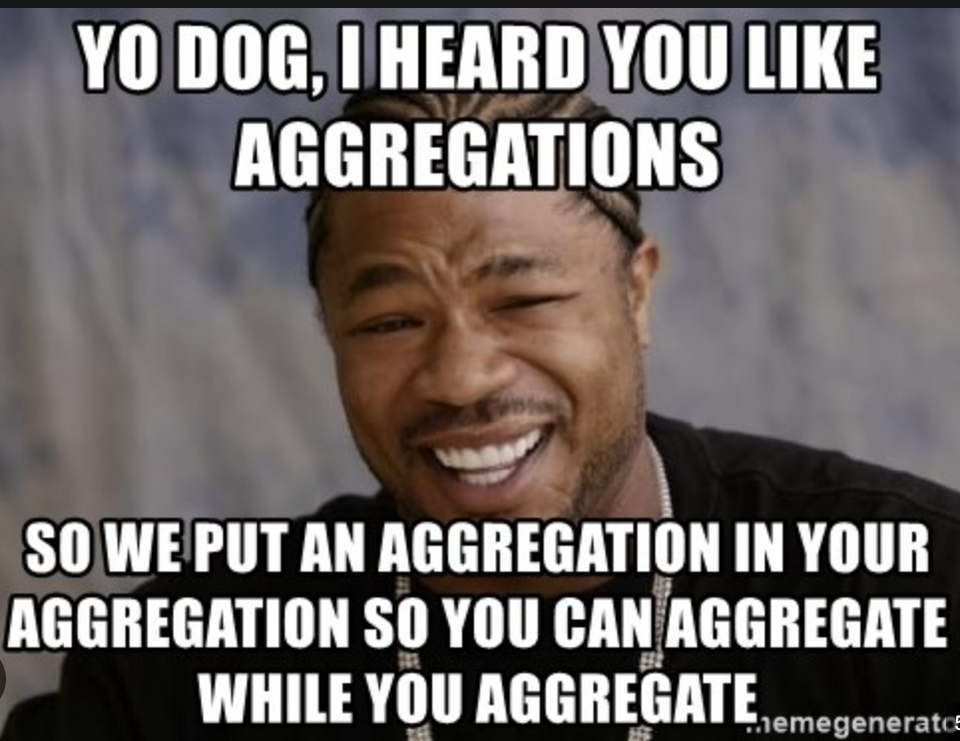
Specific examples of aggregation include: shared ordering services; for Optimistic Rollups, an interesting idea is shared batch publication, which can achieve batch compression benefits faster, especially for smaller participants, providing lower costs and higher security through faster data publication; for zk Rollups, shared provers are one of the most exciting Rollup solutions, particularly because they can recursively perform these aggregations, yielding significant benefits in efficient utilization of the L1 data market, albeit at the cost of more off-chain computation. An obvious fact is that Rollups will sooner or later choose to adopt shared services, whether as part of a Rollup alliance or as part of an economic alliance.
One direction the Rollup ecosystem may take is to have more independent Rollups closely aligned with L1. Although we have not seen many implementations yet, there are at least two interesting architectures. One is a Rollup that delegates its block ordering to L1, thereby leveraging the L1 transaction supply network for MEV extraction while retaining the power to set L2 congestion fees. A more extreme version is when the Rollup is established within Ethereum itself. When we discuss the MEV resilience and decentralization of Rollups, we will delve deeper into the economics of these models.
Rollup Cooperatives
The first type of integration between two Rollups is pure economic cooperation, such as an economic cooperative.
"A cooperative is a group of entities that share or work together to achieve common goals (such as economic benefits or savings)." --- Wikipedia
In its simplest form, there is a joint procurement agreement for some service between Rollups. Imagine a shared batch publication service that Rollups can subscribe to for lower data publication costs. More in-depth economic integration can also occur, such as shared ordering services that provide cost benefits and make it easier for transactions between Rollups to settle atomically, thereby reducing trade barriers between them. This way of thinking is similar to the European Economic Community or other similar common market associations.
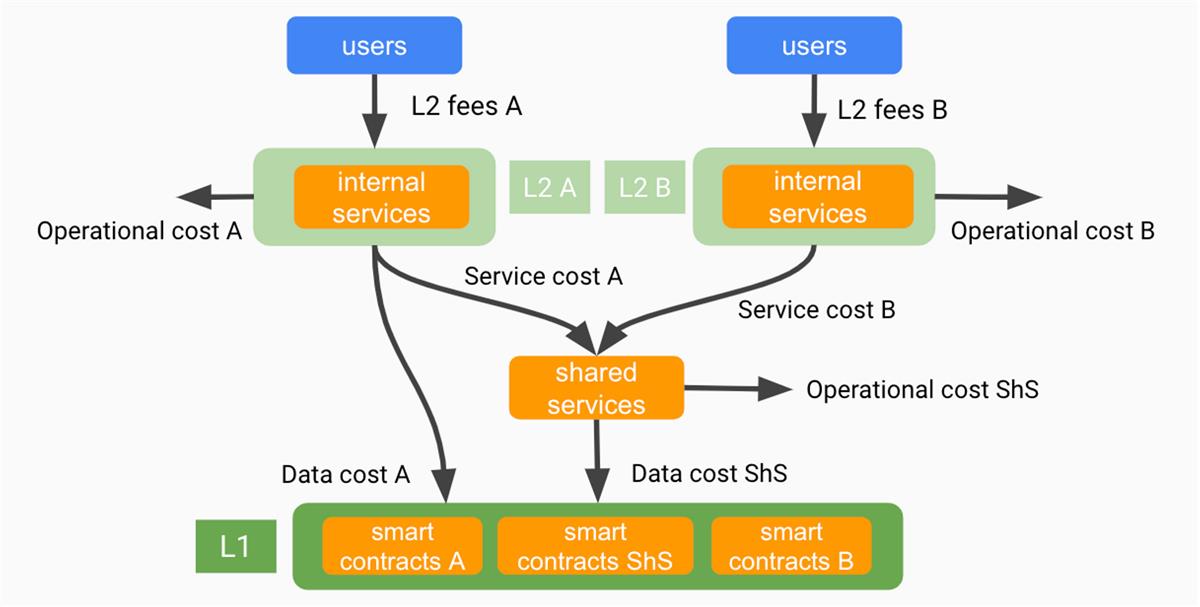
We can enhance the simple model of independent Rollup economics by introducing intermediary service providers. In this case, two new economic effects arise for the Rollup ecosystem.
Rollup Cost Structure: The costs of Rollup operators now include operational costs, service costs, and data publication costs.
Shared Service Economics: New entities need to achieve budget balance.
Examples of such services include Espresso Sorter, which is a shared service for sorting and publishing, limited to shared batch publication, or shared proving. In all these cases, shared services present two important economic issues.
L2 Service Cost Sharing: The total service costs need to be allocated to Rollups adopting shared services in an economic and fair manner.
Decentralization of Shared Services: Achieving a certain degree of decentralization, depending on the type of service, while striking an appropriate balance between performance and robustness. This standard is lower than the base layer, but it includes management incentives and MEV.
Rollup Alliances
Rollup alliances differ from economic cooperatives because they have both economic integration and some form of political integration. This way of thinking is similar to a federal state.
Technically, political integration is achieved through shared cross-chain bridges, but it also requires a shared governance system. Here, we will largely set aside political and governance considerations, assuming the existence of shared cross-chain bridges, and focus on the economic relationships they imply. This Rollup federal architecture is emerging across all major Rollup systems, which are becoming platforms for deploying interoperable peer Rollups.
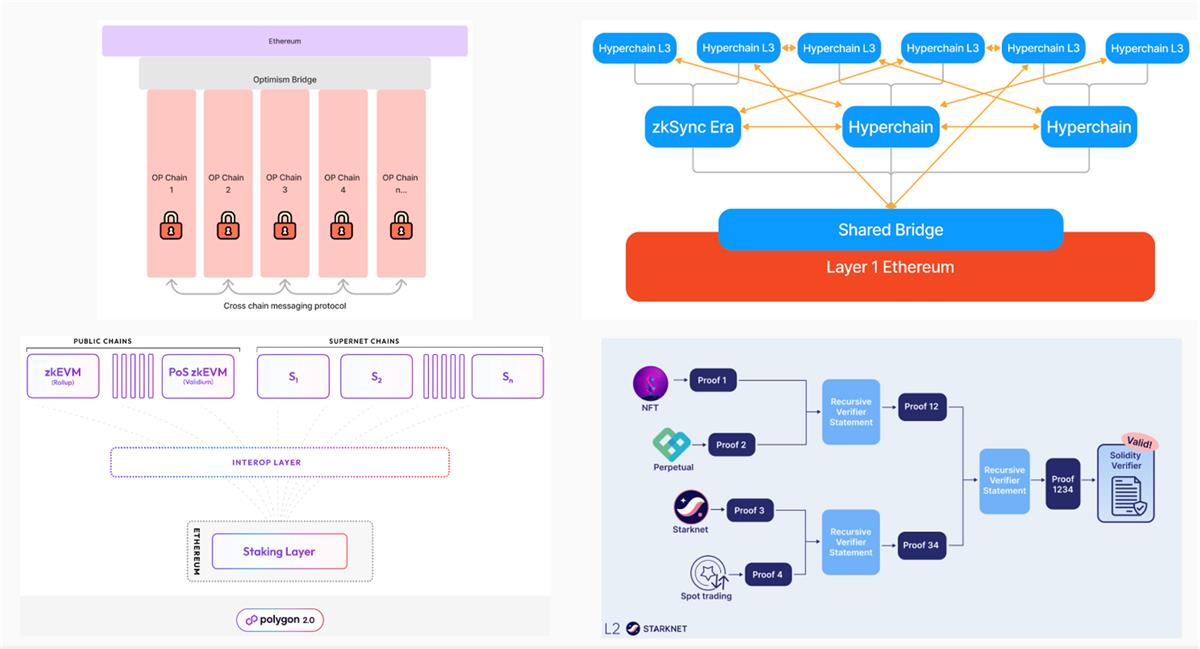
For example, Optimism Superchain, Polygon 2.0, StarkWare SHARP, zkSync Hyperchains, and other related projects share similar patterns in their architectures. We summarize this in the diagram below. Note that for effect, we make realistic assumptions that Rollup alliances automatically choose shared services and do not incur direct data publication costs.
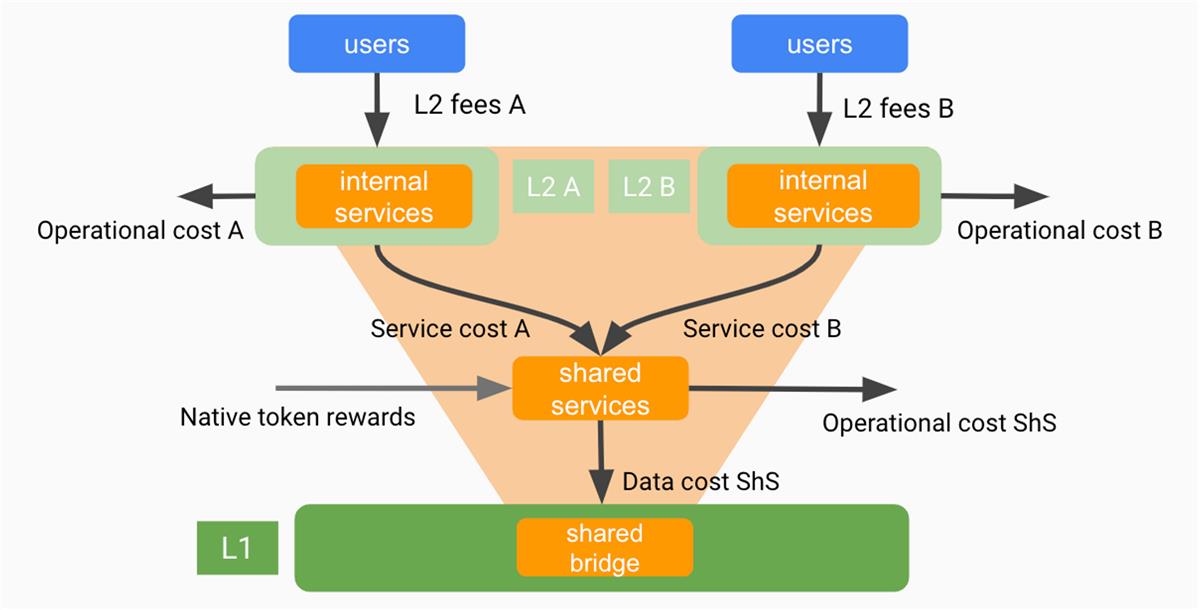
The existence of shared cross-chain bridges introduces additional economic variables. In particular, native L2 tokens, such as the OP token in the Optimism ecosystem, provide significant decision-making power through governance for resource allocation, roles, and economic flows within the ecosystem (for example, OP governance is an experiment based on mixed token identity governance). Once the Rollups technology stack matures and addresses L1 security issues, the next focus will be robustness, which may involve some degree of decentralization.
When Rollups consider establishing decentralized services (for ordering, proving, or validation), they will need to run consensus protocols. This is the time for sufficiently large ecosystems to see the opportunity to "upgrade" their native tokens into production assets (which is precisely what Polygon 2.0 plans to achieve with POL). This is not the only way to achieve decentralized L2 services, as Ethereum L1 can also leverage its superior security properties. However, for larger ecosystems that wish to retain more internal control/governance and related rewards/incentive mechanisms, using native tokens may be an attractive direction.
Native tokens are important economic tools to help guide L2 ecosystems/economies. The issuance can be used to reward service operators, fund ecosystem support projects, or public goods. However, when native tokens are used to support decentralization through some native proof-of-stake protocol, security may decrease with more dilution. Even if native tokens are only used for governance, excessive dilution may lead to more budget-constrained holders selling, potentially resulting in ownership concentration. Therefore, it seems important to have a token issuance plan that matches the growth of demand. Finally, another important consideration is to make the L2 economy more dependent on native tokens (rather than ETH), which also reduces its robustness against certain failure modes, as transferring to L1 may not be an option. In extreme cases, L2 still relies on Ethereum for security but loses the security provided by Ethereum as an external currency.
More Layers
Another actively developing area is the development of specific applications or customized execution environments that will ultimately settle on the base layer, even if not directly. These typically target applications that require low execution costs and simple deployments and are willing to make trade-offs on security, such as games, social media, NFT products that do not need to launch their own service economies, or attract/secure large amounts of liquidity.
These include different types such as L3, Validium, and Rollup as a Service (RaaS) platforms. For example, Arbitrum Orbit is a platform that supports the deployment of L3 chains on Arbitrum L2 (One or Nova) with some configurability, such as choosing Arbitrum-authorized Data Availability Committees (DAC) or Ethereum L1 as the data availability layer. StarkNet and other zk rollups projects have also been trying to implement L3. An extreme example of ease of deployment is AltLayer or Caldera, which provide no-code solutions to deploy "customizable" Rollups, empowering users to make trade-offs between security and efficiency.
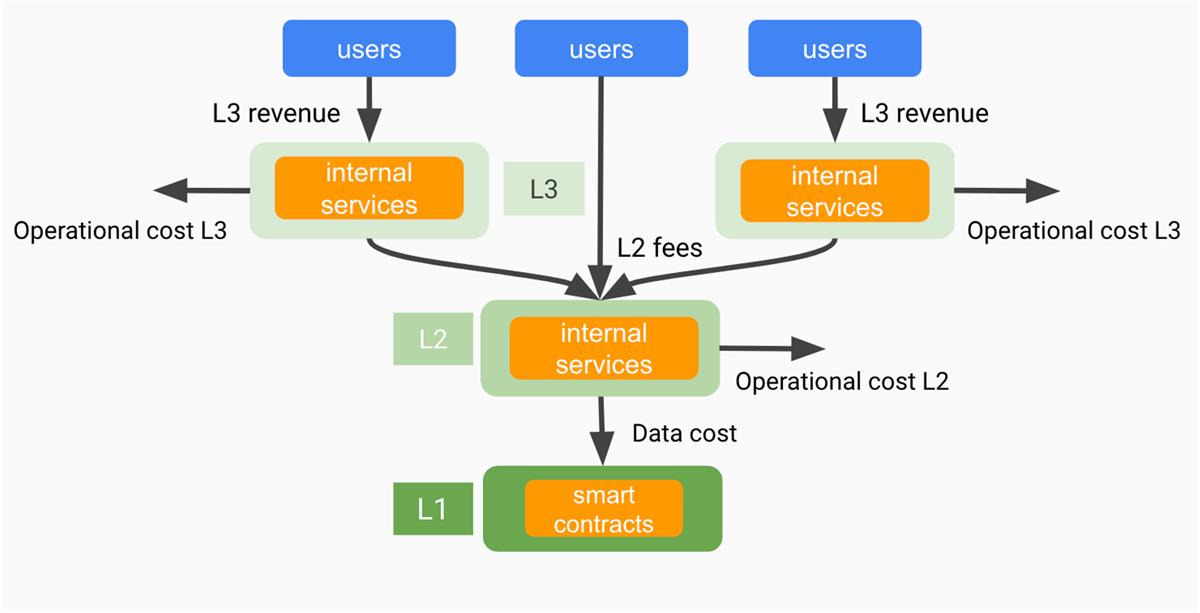
We focus on L3 systems. This is essentially a layer added on top of L2. From the perspective of L2 Rollups, this is another source of L2 fees. For the Rollup ecosystem, L3 is a new entity with its own budget balance constraints:
L3 revenue may come from fees, subscriptions (e.g., games), or other mechanisms such as revenue sharing (e.g., NFTs).
L3 costs include the operational costs of the system and the L2 fees for computation/data. These fees can be borne directly by L3 or paid by the RaaS platform in the case of hosted services. This is another service provider that needs to achieve budget balance.
This is another example of economic specialization within the Rollup ecosystem.










